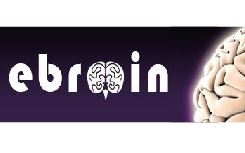by Marco Mancinetti, Dragana Viceic-Filipovic and Patrik Michel
A 72-year-old woman, known for hypertension, hypercholesterolemia and active smoking, presented with an acute “train-like” sound in her head, retrosternal chest pain and headache. She has had epigastric pain and nausea in the previous week.
Facing hemodynamic instability and an inferior myocardial infarction, the physicians in the ED of an outside hospital treated a cardiogenic shock and needed to sedate and intubate the patient. The patient was transferred to our hospital and a coronarography with coronary stenting was performed. The next day, the patient was extubated and we were called to evaluate “a new neurological deficit”. Neurological examination showed a peripheral left facial palsy with Bell’s sign associated with a left auditory loss and a right hemiataxia. Cerebral CT showed a left lower cerebellar stroke with beginning mass effect (Fig 1A). Brain magnetic resonance imaging (MRI) confirmed a stroke in the left cerebellar hemisphere corresponding to the territory of the left anterior inferior cerebellar artery (AICA) and posterior inferior cerebellar artery (PICA), and extending into the left dorsal pons (Fig 1B). Magnetic resonance angiography (MRA) demonstrated occlusion of the AICA (Fig 2).
We closely watched the patient clinically and radiologically for possible signs of mass effect. We then intensified secondary stroke prevention and continued the double anti-aggregation introduced by the cardiologists for the active coronary stents. The left eye was protected from non-closure conjunctivitis. Early neurorehabilitation was initiated and pursued during the following weeks at a neurorehabilitation center. The patient made a near complete recovery of the left hemi-ataxia, but improved only very little of her right facial palsy and the auditory loss.
Comment by the authors:
The AICA syndrome is a rare cerebrovascular condition including central and peripheral symptoms. The central symptoms are caused by a lesion of the lateral spinothalamic tract (contralateral loss of pain and temperature from the trunk and extremities), of the middle and inferior cerebellar peduncle and variable parts of the cerebellar hemispheres (ipsilateral limb and gait ataxia) and of the descending sympathetic tract (ipsilateral Horner’s syndrome). Ischemia of the facial nucleus leads to ipsilateral peripheral-appearing facial palsy and damage to the trigeminal nucleus to ipsilateral loss of sensation in the face. Other symptoms are due to true peripheral ischemia of the vestibule-cochlear nerve or even to the cochlea or vestibulum itself (Lee et al., 2009; Lee et al., 2002). These structures are supplied by the internal auditory artery, which is primarily an end artery and stems ordinarily from the AICA. In the case of this patient, treating a vital cardiac pathology hid the presence of a potentially fatal neurological condition. Indeed, every extended ischemia in the posterior circulation carries an important risk of cerebellar herniation. Whereas an AICA stroke rarely suffices to produce significant mass effect, our patient had simultaneous PICA territory infarction, either as a variant of the cerebellar blood supply, or as thrombus embolisation into the AICA and the PICA. Given that the brainstem signs in our patient were explained by ischemia rather than mass effect, and the patient remained stable, no decompressive posterior craniectomy was performed. Thus, repeating a CT or a MRI at an early stage in a patient with an acute cerebellar or vestibular syndrome and a normal initial head CT may be a life saving procedure. If large volume cerebellar stroke is present, the patient should be closely monitored in an intermediate or intensive care unit, and posterior fossa craniectomy with partial infarct resection may be a lifesaving procedure (Pfefferkorn et al., 2009).
References:
Lee, H., Kim, J.S., Chung, E.J., Yi, H.A., Chung, I.S., Lee, S.R., Shin, J.Y., 2009. Infarction in the territory of anterior inferior cerebellar artery: spectrum of audiovestibular loss. Stroke 40, 3745-3751.
Lee, H., Sohn, S.I., Jung, D.K., Cho, Y.W., Lim, J.G., Yi, S.D., Lee, S.R., Sohn, C.H., Baloh, R.W., 2002. Sudden deafness and anterior inferior cerebellar artery infarction. Stroke 33, 2807-2812.
Pfefferkorn, T., Eppinger, U., Linn, J., Birnbaum, T., Herzog, J., Straube, A., Dichgans, M., Grau, S., 2009. Long-term outcome after suboccipital decompressive craniectomy for malignant cerebellar infarction. Stroke 40, 3045-3050.
Marco Mancinetti, Dragana Viceic-Filipovic and Patrik Michel work at the Service of Neurology at the Department of Clinical Neurosciences of the Centre Hospitalier Universitaire Vaudois in Lausanne, Switzerland.
Comment by Gian Luigi Lenzi
AICA is the most variable of the cerebellar arteries and has the smallest zone of supply within the cerebellum: it usually supplies the inner ear, lateral pons, middle cerebellar peduncle, and anterior inferior cerebellum including the flocculus. (see also http://www.ncbi.nlm.nih.gov/pubmed/2302529)
AICA commonly originates from the lower half of the basilar artery; however there are common anatomic variants, in which AICA dominance on one side and PICA dominance on the opposite side are commonly seen in normal persons. At times either the AICA or PICA is absent or hypoplastic, in which case one AICA-PICA supplies the usual territory of both arteries.
This could be the case in this patient from Lausanne, who showed AICA and PICA infarctions.
Since AICA always supplies the lateral pontine tegmentum and middle cerebellar peduncle, AICA territory infarcts usually involve the brainstem and are virtually never limited to the cerebellum itself (whereas infarcts in the territory of the PICA or SCA usually involve only the cerebellum).
Infarction in the territory of any of the three cerebellar arteries results in limb and gait ataxia. Vertigo is particularly common in infarcts in the PICA and AICA territories. AICA territory infarcts almost always include the lateropontine area and are frequently predominated by brainstem signs. Therefore the AICA syndrome is equivalent to a lateral pontine syndrome.
Infarctions in the AICA territory are the least common from all cerebellar strokes.
Often AICA occlusion coexists with the occlusion of the caudal part of the basilar artery.
The most frequent mechanism is atherosclerotic thrombosis.
In this patient, the temporal coincidence of an important cardiac ischemia could suggest an embolic mechanism, but we tend to emphasize the “hemodynamic instability” reported by Mancinetti and colleagues, thus the thrombotic mechanism.
The classic syndrome of AICA occlusion involves vertigo, tinnitus, ipsilateral hearing loss, dysarthria, peripheral facial palsy, Horner’s syndrome, multimodal facial hypoestesia (trigeminal sensory loss), and ipsilateral limb ataxia accompanied by contralateral thermanalgesia of the limbs and trunk.
Partial AICA can be confused with Wallenberg’s syndrome.
AICA complete occlusion may be presenting with coma and tetraplegia.
Acute AICA presentation may be without neurological signs and symptoms, and often these patients are referred to the ORL competence. Accordingly, this Lausanne patient presented with a train-like sound in her head, besides the cardiac symptoms, and without neurological deficits (if we do not want to consider headache in such a presentation).
All these findings suggest that the clinicians, both ORL or neurologists, as well as in the ED, should keep in mind the differential diagnosis of a posterior circulation stroke when caring for patients with acute peripheral-type audiovestibular syndrome, especially in patients with vascular risk factors and/or other vascular pathologies.
Posterior circulation ischemic strokes are “emergency” neurological cases, and we fully agree with Mancinetti and colleagues for stressing the relevance of a close monitoring in an intermediate care unit, because craniectomy may be mandatory if brain stem compression increases.










